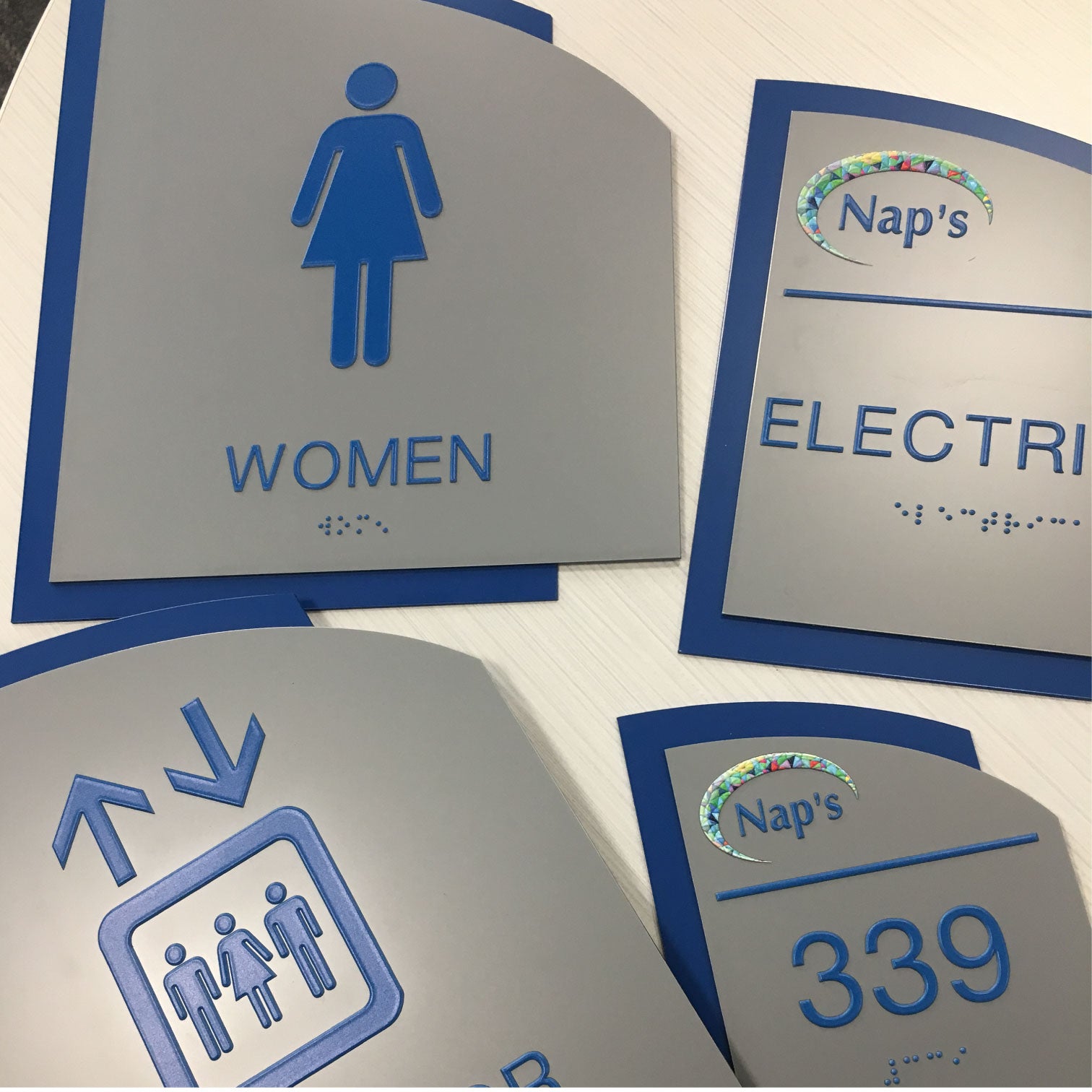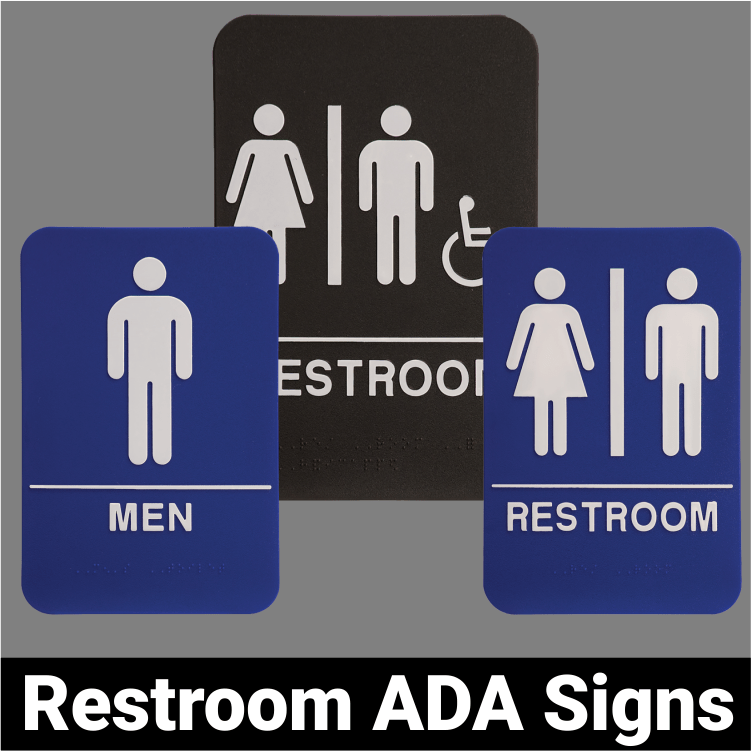The Role of ADA Signs in Complying with Ease Of Access Criteria
Just How ADA Indicators Change Rooms for Individuals With Disabilities
The makeover of spaces through ADA signs for people with impairments is an extensive testimony to the power of availability. By adhering to ADA conformity, environments end up being risk-free and navigable, with indicators that attribute important components like high-contrast colors and Braille, thereby boosting presence and comprehension.

Relevance of ADA Compliance
Making certain ADA conformity is not only a lawful commitment yet additionally a societal commitment to inclusivity and access. By adhering to the guidelines stated in the Americans with Disabilities Act (ADA), organizations show their commitment to creating environments where individuals with handicaps can involve and navigate without obstacles. ADA conformity is important in eliminating discrimination, cultivating equality, and advertising independence for people with handicaps.
Businesses and public establishments profit substantially from ADA conformity. By guaranteeing facilities are available to every person, companies can attract a more comprehensive consumer base, consisting of the 61 million Americans living with handicaps.
Furthermore, ADA compliance is a foundation of universal design, which highlights producing areas that fit all people, no matter their abilities. By executing certified signs and functions, companies add to a much more equitable culture, where all participants can participate completely. Inevitably, ADA compliance transcends legal commitment, embodying a societal value that focuses on empowerment and equivalent possibility for every person.
Enhancing Navigation and Security
Navigating rooms with confidence and safety and security is vital for people with disabilities, and ADA-compliant signage plays an essential role in attaining this goal. These indicators are developed with certain functions to accommodate the diverse demands of individuals with numerous disabilities, thus promoting smoother and more secure navigation throughout public and private spaces. By supplying clear, standardized information, ADA signs reduce confusion and promote a higher sense of independence for people that rely on them.
The tactical placement of ADA indicators guarantees that crucial details comes to everybody, including those with aesthetic, acoustic, or cognitive disabilities. For example, tactile and Braille elements on indicators help visually damaged individuals independently locate exits, bathrooms, and various other vital locations. In emergency situations, ADA signs add to efficient evacuations by plainly noting emergency situation departures and courses, hence enhancing safety and security for all owners.
Furthermore, ADA-compliant indications foster an inclusive setting by attending to the one-of-a-kind navigating challenges dealt with by people with specials needs. This not just help in their personal safety but additionally urges engagement in social activities by advertising equal accessibility to civil services and facilities. Inevitably, reliable ADA signage transforms spaces right into accessible, safe, and inviting atmospheres for everybody.
Functions of Efficient ADA Indicators
To develop efficient ADA indicators, it is vital to incorporate particular features that address the varied availability demands of individuals with disabilities. One important function is using high-contrast colors, which significantly boost presence for people with aesthetic impairments. The background and message ought to contrast greatly to make certain the info is easily discernible. Furthermore, the message needs to be in a sans-serif typeface, as these typefaces supply more clear readability at a distance.
An additional necessary feature is responsive components, such as increased characters and Braille, promoting access for visually damaged individuals. The elevated personalities should be at the very least 1/32 inch above the surface area, allowing for simple touch analysis. Braille ought to be positioned directly listed below equivalent message, making sure consistency and convenience of navigating.
The positioning of ADA signs is likewise essential for their performance. By incorporating these attributes, ADA indications can considerably improve wayfinding and ease of access for all.
Impact on Neighborhood Addition
ADA signs substantially contribute to neighborhood addition by making certain that public spaces are accessible and available for people with specials needs. These indications, created in compliance with the Americans with Disabilities Act (ADA), attribute tactile aspects, braille, and high-contrast shades, assisting not just those with aesthetic disabilities but a varied series of specials needs - ADA Signs. As a result, they play a pivotal function in producing settings where individuals with impairments can take part completely and independently in area life

Moreover, ADA indications aid institutions and organizations fulfill legal responsibilities, thereby stopping prospective discrimination claims and boosting their track records as inclusive entities. Ultimately, ADA indications are indispensable tools in the ongoing initiative to develop more equitable and accessible areas for everyone.
Future Trends in Accessible Signage
The combination of innovative technologies guarantees to change exactly how individuals with specials needs communicate with their environments. Digital signs outfitted with sensors and connectivity can engage with personal tools to provide customized details, such as text-to-speech for aesthetically impaired users or simplified graphics for those with cognitive impairments.
Increased reality (AR) additionally holds significant capacity. AR applications can overlay digital information onto real-world environments, supplying customers with improved navigational help and contextual details (ADA Signs). This can be specifically beneficial in complex settings like flight terminals or large public locations where conventional signs might fail
An additional arising fad is the incorporation of Internet of Points (IoT) innovation to produce a network of interconnected signs. This permits for real-time updates and boosted ease of access, adjusting to changes in the environment or customer demands. Furthermore, with the expanding focus on inclusivity, future guidelines might push for also extra advanced signs remedies, making sure universal gain access to and cultivating a much more inclusive culture for all people.
Verdict
ADA indications play an essential function in transforming spaces for people with handicaps by ensuring availability and advertising freedom. Compliance with ADA standards boosts navigation and safety and security through the use of high-contrast shades, responsive elements, and Braille.
The makeover of areas via ADA indications for people with impairments is an extensive testament to the power of ease of access.To produce reliable ADA signs, it is essential to incorporate details attributes that address the varied ease of access demands of people with impairments.ADA indicators dramatically add to community incorporation by ensuring that public rooms are navigable and accessible for people with specials needs.By facilitating the ease of motion and understanding within public rooms, ADA indicators cultivate a sense of belonging and empowerment amongst people with handicaps.ADA signs play a crucial useful reference role in transforming spaces for people with handicaps by ensuring accessibility and advertising independence.